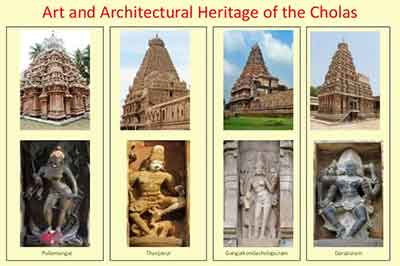Chola Art
CONTEXT:
Announcement by the National Gallery of Australia to return 14 works of art to India from its Asian art collection has brought the Chola dynasty and their art work in limelight.
FOR PRELIMS:
- 13 amongst the 14 art pieces are a collection of art dealer Subash kapoor called 'Art of the Past'
- One is from art dealer William Wolff.
- The 14 art-works consists of six bronze or stone sculptures, a brass processional standard, a painted scroll, and six photographs.
- These are:
- The works being returned are: Child-saint Sambandar,
- dancing child-saint Sambandar of 12th century belonging to Chola dynasty,
- Processional standard [‘alam], from Hyderabad,
- Arch for a Jain shrine, 11th-12th century,
- Seated Jina, 1163 from Mount Abu region, Rajasthan,
- The divine couple Lakshmi and Vishnu [Lakshmi Narayana] 11-12th century,
- Durga Mahisasuramardini, from Gujarat.
ABOUT CHOLA DYNASTY AND THEIR ART
- The Chola dynasty, also called as Imperial Cholas, ruled successfully for four centuries i.e. 875-1175 AD after the Pallava dynasty.
- Their kingdom was mainly established in and around South India.
- Also, The Cholas conquered parts of Gujarat, Malwa, Deccan and Indonesia, Lakshadweep, Maldives and Sri Lanka in entirety.
- Bay of Bengal came to be known as the ‘Chola Lake’ as they dominated the area with their powerful navy.
- The entire coast from Kanyakumari to Bengal came to be captioned ‘Cholamandalam’. Coromandel is the anglicised name of Cholamandalam.
- Brihadeswara temple, Airavateswara temple, Koranganatha temple and others are some finest examples of Dravidian architecture at its peak during their rule.
- The main character of the Chola architecture is the 'Vimana' that consists of 6-7 storeys above the main hall with flat roof.
- Pillared mandapams, for example, ardha mandapa, maha mandapa and nandi mandapa, are the main attractions of Chola temples.
- Octagonal shikhara of Gangaikondacholapuram temple is the living proof of evolving styles of monolith shikharas during this period.
- The bronze statue of Nataraja is the classic example of great craftsmanship during this period that existed beyond temple walls
- Bronze idol making was a very important and significant skill during this period.
- The Chola rulers were great patrons of Art and literature. They fostered education and mostly followed Vedic religion.
Source
- The Hindu







